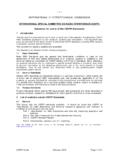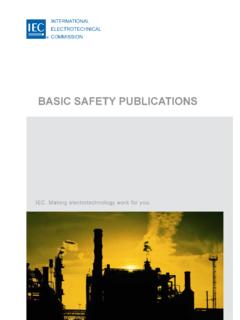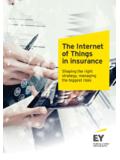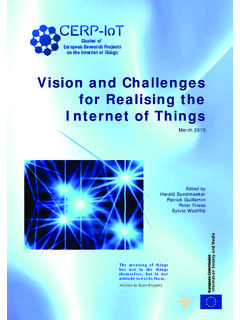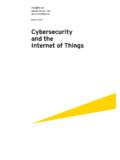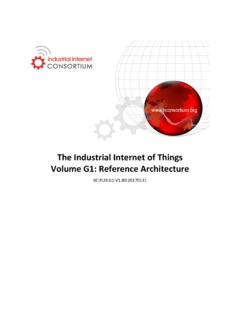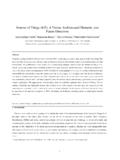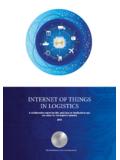Transcription of Internet of Things: Wireless Sensor Networks
1 Internet of Things: Wireless Sensor Networks White Paper3 Today, smart grid, smart homes, smart water Networks , intelligent transportation, are infrastruc-ture systems that connect our world more than we ever thought possible. The common vision of such systems is usually associated with one single con-cept, the Internet of things (IoT), where through the use of sensors, the entire physical infrastructure is closely coupled with information and communica-tion technologies; where intelligent monitoring and management can be achieved via the usage of net-worked embedded devices. In such a sophisticat-ed dynamic system, devices are interconnected to transmit useful measurement information and con-trol instructions via distributed Sensor Wireless Sensor network (WSN) is a network formed by a large number of Sensor nodes where each node is equipped with a Sensor to detect physical phenomena such as light, heat, pressure, etc.
2 WSNs are regarded as a revolutionary information gathering method to build the information and communication system which will greatly improve the reliability and effi ciency of infrastructure systems. Compared with the wired solution, WSNs feature easier deployment and better fl exibility of devices. With the rapid technological development of sensors, WSNs will become the key technology for this White Paper we discuss the use and evolution of WSNs within the wider context of IoT, and provide a review of WSN applications, while also focusing the attention on infrastructure technologies, applications and standards featured in WSN designs. This White Paper is the sixth in a series whose purpose is to ensure that the IEC can continue to contribute with its International Standards and Conformity Assessment services to solve global problems in 2 starts with the historical background of IoT and WSNs, then provides an example from the power industry which is now undergoing power grid upgrading.
3 WSN technologies are playing an important role in safety monitoring over power transmission and transformation equipment and the deployment of billions of smart 3 assesses the technology and charac-teristics of WSNs and the worldwide application needs for them, including data aggregation and 4 addresses the challenges and future trends of WSNs in a wide range of applications in various domains, including ultra large sensing device access, trust security and privacy, and service architectures to name a 5 provides information on applications. The variety of possible applications of WSNs to the real world is practically unlimited. On one hand, WSNs enable new applications and thus new possible markets; on the other hand, the design is affected by several constraints that call for new paradigms. This section outlines WSN uses for the smart grid, smart water, intelligent transportation systems, and smart home 6 offers analysis of standardization being a major prerequisite in achieving the interoperability of WSNs, not only between products of different vendors, but also between different solutions, applications and 7 concludes with a number of key recommendations for industry, regulators, the IEC, and general observations on WSN security and data summary4 AcknowledgmentsThis White Paper has been prepared by the Wireless Sensor Networks project team, in the IEC Market Strategy Board.
4 The project team includes:Dr. Shu Yinbiao, Project Leader, MSB Member, SGCCDr. Kang Lee, Project Partner, NISTMr. Peter Lanctot, IECDr. Fan Jianbin, SGCCDr. Hu Hao, SGCCDr. Bruce Chow, Corning IncorporatedMr. Jean-Pierre Desbenoit, Schneider ElectricMr. Guido Stephan, SiemensMr. Li Hui, SiemensMr. Xue Guodong, HaierMr. Simon Chen, SAPMr. Daniel Faulk, SAPMr. Tomas Kaiser, SAPMr. Hiroki Satoh, HitachiProf. Ouyang Jinsong, ITEI ChinaMr. Wang Linkun, ITEI ChinaMs. Wang Shou, ITEI ChinaDr. Zhen Yan, Nari Group CorporationDr. Sun Junping, China-EPRIProf. Yu Haibin, SIADr. Zeng Peng, SIADr. Li Dong, SIADr. Wang Qin, University of Science and Te c h n o l o g y, B e i j i n gExecutive summary5 List of abbreviations 9 Glossary 12 Section 1 Introduction O ve r v iew Scope of this White Paper 14 Section 2 History and industrial drivers of WSNs 15 Section 3 WSN technology Characteristic features of WSNs Sensor nodes Miniaturization technology of Sensor based on MEMS Ambient energy harvesting technology Access network technologies Topology Self-organizing and reliable networking technology Low cost IP interconnection technology Self-adaptive fl ow control technology Data aggregation Security Trust, security and privacy Crypto algorithms Key management of WSNs Secure routing of WSNs Secure data aggregation of WSNs 32 Table of contents6 Table of contentsSection 4 Challenges of WSNs System qualities.
5 Architecture divergence, and the need for an architecture framework Ultra-large sensing device access Massive heterogeneous data processing Intelligent control and services to dynamic changes Sensor network architecture High concurrent access High concurrent access with frequency division multiplexing High concurrent access with distributed antenna systems High real-time transmission Distributed solution Centralized solution Semantic representation and processing More secure WSNs Protocol security framework Trust, security and privacy 41 Section 5 WSN applications in the infrastructure systems WSN application in the smart grid Online monitoring system for transmission lines Intelligent monitoring and early warning system for substations Online monitoring and early warning system for distribution Networks Smart electricity consumption services WSN application in smart water Networks Sustainability (water resource focus)
6 WSN application in intelligent transportation Sensing of traffi c fl ows City logistics On-board WSNs WSN in traffi c infrastructures WSN application in smart homes The energy challenge Energy effi ciency in buildings Case study Active control in buildings WSNs are key for improving the energy effi cient performances of existing buildings Additional application benefi ts of WSN Improve energy effi ciency Contribute to environmental monitoring Enhance social services 57 Section 6 Standards of WSNs and systems General Present status Standardization needs and outlook Challenges and future standardization needs 68 Section 7 Conclusions and recommendations General recommendations Recommendations addressed to the IEC and its committees 70 Annex A Access technologies Developing trend of access technologies Bluetooth IEEE WLAN IEEE 73 References 75 Table of contents9 ABS anti-lock braking system AMI advanced metering infrastructure CAPEX capital expenditure CoAP constrained application protocol COSEM companion specifi cation for energy metering CPU control processing unit DLMS device language message specifi cation DSN distributed Sensor network ESC electronic stability control FCD fl oating car data FDM frequency-division multiplexing FH frequency hopping GHG greenhouse gases GPS global positioning system ICT information and communication technologies IoT Internet of things KPI key performance indicator M2M machine to machine MAC media access control MEMS microelectromechanical systems MIMO multiple-input multiple-output
7 OEM original equipment manufacturer OFDM orthogonal frequency-division multiplexing OPEX operational expenditure PHY physical layer PV photovoltaic QoS quality of service RES renewable energy sourceList of abbreviationsTechnical andscientifi c terms RFID radio-frequency identifi cation SOA service oriented architecture SOAP service oriented architecture protocol TDMA time division multiple access TSMP time synchronized mesh protocol TSP trust, security and privacy UCC urban consolidation centre USN ubiquitous Sensor network WIA-FA Wireless Networks for industrial automation factory automation WIA-PA Wireless Networks for industrial automation process automation WISA Wireless interface for sensors and actuators WLAN Wireless local area network WMAN Wireless metropolitan area network WPAN Wireless personal area network WSN Wireless Sensor network WWAN Wireless wide area network XFCD extended fl oating car data ABB ABB Group ARPANET Advanced Research Projects Agency network BBF Broadband Forum CAB Conformity Assessment Board (of the IEC) China-EPRI China Electric Power Research Institute DARPA Defense Advanced Research Projects Agency (USA)
8 ETSI European Telecommunications Standards Institute IEC International Electrotechnical Commission IEEE Institute of Electrical and Electronics Engineers IETF Internet Engineering Task Force ISO International Organization for Standardization ITEI Instrumentation Technology and Economy Institute (China)Organizations, institutions and companiesList of abbreviations11 ITU-T International Telecommunication Union Telecommunication Standardization Sector MSB Market Strategy Board (of the IEC) NIST National Institute of Standards and Technology OGC Open Geospatial Consortium OMA Open Mobile Alliance SGCC State Grid Corporation of China SIA Shenyang Institute of Automation (China) SMB Standardization Management Board (of the IEC) UCB University of California Berkeley (USA) W3C World Wide Web ConsortiumList of abbreviations12 Glossaryinternet of thingsIoTrefers to the interconnection of uniquely identifi able embedded computing-like devices within the existing Internet infrastructuremedia access control layerMAC layerpart of the data link protocol that controls access to the physical transmission medium in IEEE 802 Networks (LANs)system on a chipSoCintegrated circuit (IC) that integrates all components of a computer or other electronic system into a single chiptime synchronized mesh protocolTSMPa networking protocol that forms the foundation of reliable, ultra low-power Wireless Sensor networkingwireless local area networkWLAN local area network in which data are transferred without the use of wireswireless metropolitan area networkWMAN also known as a Wireless local loop (WLL).
9 WMANs are based on the IEEE standard. Wireless local loop can reach effective transfer speeds of 1 to 10 Mbps within a range of 4 to 10 kilometreswireless personal area networkWPANa low-range Wireless network which covers an area of only a few dozen metreswireless Sensor networkWSNself-organizing, multi-hop Networks of Wireless Sensor nodes used to monitor and control physical phenomenawireless wide area networkWWAN Wireless network that provides communication services to a geographic area larger than a single urban area. The most common of all Wireless networks13 Section 1 OverviewToday sensors are everywhere. We take it for granted, but there are sensors in our vehicles, in our smart phones, in factories controlling CO2 emissions, and even in the ground monitoring soil conditions in vineyards. While it seems that sensors have been around for a while, research on Wireless Sensor Networks (WSNs) started back in the 1980s, and it is only since 2001 that WSNs generated an increased interest from industrial and research perspectives.
10 This is due to the availability of inexpensive, low powered miniature components like processors, radios and sensors that were often integrated on a single chip (system on a chip (SoC)).The idea of Internet of things (IoT) was developed in parallel to WSNs. The term Internet of things was devised by Kevin Ashton in 1999 [1] and refers to uniquely identifi able objects and their virtual representations in an Internet -like structure. These objects can be anything from large buildings, industrial plants, planes, cars, machines, any kind of goods, specifi c parts of a larger system to human beings, animals and plants and even specifi c body parts of IoT does not assume a specifi c communi-cation technology, Wireless communication tech-nologies will play a major role, and in particular, WSNs will proliferate many applications and many industries. The small, rugged, inexpensive and low powered WSN sensors will bring the IoT to even the smallest objects installed in any kind of envi-ronment, at reasonable costs.






